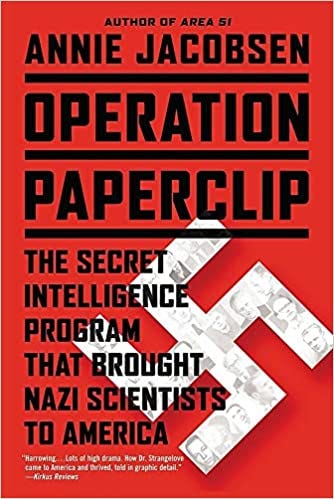TLDW - An Uncensored History of DARPA [and the Pentagram]
Annie Jacobsen presents her book at Talks at Google
Annie Jacobsen loves the controversial topics just like we do and that is why the said activities of the Nazis and the Pentagram folks are so important to make not of if we are to Decode our way out of the Masonic Pentagram Nazi Matrix. This author knows of the Nazi history and even wrote a book on Operation Paperclip, the American Nazi Alliance that was established after the end of WWII with the mass transfer of Nazi Scientists, Engineers and Technology. That Alliance would give birth to DARPA.
But who has the time to watch long videos? Answer, nobody does so here is another TLDW - Too Long Did not Watch series. Also see some of our previous posts on the Nazis and the Pentagram.
Georgia Guidestones destroyed by Missile Strike like Pentagram 911?
The granite Georgia Guidestones are now officially no more. The first explosion or missile strike took out one structure, like the first tower dropping on 911. The other buildings were brought down by explosions in the buildings, not anything to do with the planes and jet fuel. And here symbolically that is what happened once again, bulldozers “pulled” …
An Alternative Nazi History of America
We present An Alternative Nazi History of America and of our recent past. This video is from Super Soldier Talk Live and this Episode deals with the Secret Space Program 101 - with James Rink, Johan Fritz and FESIG.
An Uncensored History of DARPA | Annie Jacobsen | Talks at Google
00:03 Introduction
Section Overview: Annie Jacobsen introduces herself and her book, "The Pentagon's Brain," which is about DARPA.
Applause from the audience.
Annie Jacobsen thanks Google for having her and introduces herself as the author of "The Pentagon's Brain."
She mentions that DARPA is sometimes referred to as "the Pentagon's brain."
00:24 Getting Access to Classified Information
Section Overview: Annie Jacobsen talks about how she gains access to classified information for her writing.
One of the most frequent questions she gets asked is how she gains access to classified information.
She shares advice from a physicist who invented stealth technology for the government: "fortune favors the prepared mind" and "look up, not down."
Physicists are always looking up to understand mysteries, whether it's bees, birds, bats, or the cosmos.
If someone says no to sharing information, go to their boss. The most knowledgeable people often want to share their information.
01:11 Looking Up and Sharing Information
Section Overview: Annie Jacobsen discusses how scientists stay abreast of unclassified information and share knowledge with others.
All national security scientists are real patriots who care about this country.
They stay abreast of what is unclassified so they can share that information with others.
Three scientists she worked with on this book include Charles Townes (inventor of laser), Murph Goldberger (co-founder of Jason scientists), and Joseph Zasloff (social scientist who ran program during Vietnam War).
03:07 Interviewing Charles Townes
Section Overview: Annie Jacobsen shares how she was able to interview Charles Townes despite being denied access by others.
She was trying to learn about laser beam weapons but no one would tell her anything.
She followed Lavik's lead and looked up to find Charles Townes, who was still giving interviews at age 98.
He told her amazing stories about the laser and early laser development.
04:09 The Jason Scientists
Section Overview: Annie Jacobsen talks about the Jason scientists, who are among the most elite and secretive defense scientists in the nation.
The Jason scientists were created in 1960 specifically to work for DARPA (then called ARPA).
They are perhaps the most elite, most secretive defense scientists in the nation.
04:34 Social Science and DARPA
Section Overview: Annie Jacobsen discusses how social science played a role in both the Vietnam War and Iraq War, and how DARPA is involved in social science.
Joseph Zasloff ran a program during the Vietnam War called the Viet Cong Motivation and Morale Program.
It was interesting to see how social science played a role in war efforts.
DARPA is an organization that is so involved in high technology weapons, but also involved in social science.
05:18 The Beginning of DARPA
Section Overview: In this section, the speaker talks about how the truth has many parts to it and how government secrecy always leaves room for more revelations. The speaker also discusses the development of autonomous robotics and its use in weapons systems.
The Development of Autonomous Robotics
05:42 The speaker shows a video of the DARPA Cheetah robot that can run at 28 miles per hour.
06:07 The speaker explains that autonomous robotics is where weapons are heading.
07:56 John von Neumann was one of the first people in the United States who had an idea that computers could think. He built a machine computer and called what we now call software, "the computer's organs."
06:48 John von Neumann: The First Pentagon's Brain
Section Overview: In this section, the speaker talks about John von Neumann, who was considered as the smartest man in Washington DC during his time. Von Neumann was responsible for solving solutions for the Pentagon.
Von Neumann's Contributions
07:10 Von Neumann played a significant role in determining when to drop atomic bombs on Hiroshima by doing math calculations in his head at an extraordinary speed.
07:33 Von Neumann was known as a human computer because he could do complex calculations quickly.
07:56 Von Neumann built a machine computer and called what we now call software, "the computer's organs."
08:20 Why DARPA Was Created
Section Overview: In this section, the speaker talks about why DARPA was created and how scientists had created weapons against which there is no defense.
Creation of Weapons Against Which There Is No Defense
08:42 The speaker shows a photograph of the thermonuclear bomb going off in the Marshall Islands, which was supposed to be six megatons but ended up being 15 megatons.
09:26 DARPA scientists calculated down to the second how many seconds it takes for a nuclear weapon to leave the Soviet Union and travel to Washington DC. It takes 1,600 seconds.
09:50 DARPA was created to defend against weapons that there is no defense against.
10:56 Surviving a Nuclear Bomb
Section Overview: The speaker discusses the construction of a bunker that was built to withstand a nuclear bomb. He explains that unless one has access to such a bunker, there is no way to survive a nuclear bomb.
Building the Bunker
10:56 The bunker was built to wild specifications and barely kept the men alive.
11:17 The speaker has all the specs in his book.
11:43 There is no way to survive a nuclear bomb without having access to such a bunker.
12:09 DARPA and Technological Superiority
Section Overview: The speaker talks about how DARPA began as an organization created specifically for America to maintain technological superiority over the Soviet Union after Sputnik. He also mentions some concerns about where weapons technology is going.
Weapons Technology and DARPA
12:09 DARPA began as an organization created specifically for America to maintain technological superiority over the Soviet Union after Sputnik.
12:34 DARPA is a double-edged sword with serious concerns raised in the book about where weapons technology is going.
12:56 Murph Goldberger, founder of Jason, talks about what it was like working on major DARPA programs in its early days.
Controversial Weapons Programs
13:41 Kennedy and LBJ authorized some of the most controversial DARPA weapons ever to exist.
14:09 ARPA was sent into Vietnam by Johnson, who made a deal with President Diem to create weapons facilities in Saigon and begin manufacturing state-of-the-art weaponry for Vietnamese soldiers.
14:30 Project Agile was created by ARPA for Vietnam, which included pushing through the AR-15 rifle to replace the semiautomatic weapons that Vietnamese soldiers were having trouble handling.
Chemical Warfare
14:53 Because DARPA had its hands in so many different pieces of the pie, chemical warfare became a DARPA program, and Agent Orange was sprayed over the jungles.
15:12 Agent Orange was perceived to be the magic bullet that might end the war, but it did not.
15:59 Technology in 1960
Section Overview: The speaker talks about technology in 1960 and how it was used during nuclear decision-making.
Nuclear Decision-Making
15:59 In case of a nuclear decision needing to be made, Khrushchev or Kennedy had a bright red telephone installed in their homes.
16:19 The analog idea meant that if a decision needed to be made, it had to go through a White House operator on our end before going through.
16:52 The Origins of the Internet
Section Overview: In this section, the speaker talks about the origins of the internet and how it started as an idea to create an intergalactic network.
The ARPANET at ARPA
16:52 The internet was initially called C2.
17:00 It started out first as the ARPANET at ARPA.
McNamara's Electronic Fence
18:01 McNamara's electronic fence was a string of sensors with audio technology that was used to detect fighters on the Ho Chi Minh trail in Vietnam.
18:25 This is where all sensor technology began, and it led to programs like those used by the NSA today.
19:29 The information gathered from these sensors would be sent up to an aircraft flying around in a racetrack formation. Then it goes back to an information center at a US airbase in Thailand.
20:11 This idea was ridiculed by generals at the Pentagon.
Harold Brown's Strategy
21:34 Harold Brown came up with a new strategy that made science and technology an industry at the Pentagon. He put into play long term research projects with all of that sensor technology which would build all the way to the Gulf War.
22:24 The Origins of DARPA
Section Overview: In this section, the speaker discusses how the idea of a perimeter fence was created during the Vietnam War and how it evolved into an area network. The Pentagon began looking at some of the technology from the Vietnam War and rebundling it to create more effective technology.
Evolution of Technology
22:24 During the Vietnam War, a perimeter fence was created as an electronic fence.
22:48 The Pentagon began looking at some of the technology from the Vietnam War and rebundling it to create more effective technology.
23:10 As things got smaller, they could be more effective in war theater. Two of the earliest drones were reconfigured helicopters that used to fly off submarines.
23:30 The Pentagon spent all the way until late '80s pushing technology, sensor technology, drone technology, building entire industries.
Network-Centric Warfare
23:52 ARPANET became internet and there was a movement toward what is now called network-centric warfare.
24:22 In Gulf War with Secretary of Defense Cheney in charge, it became evident that technology could win a war like that instantly.
25:10 Urban Warfare
Section Overview: This section discusses DARPA's interest in urban warfare after Mogadishu incident in 1992. It also talks about Soviet scientists who defected to US after Berlin Wall fell and started working for DARPA.
Urban Warfare
25:33 DARPA had a big problem in urban warfare and they knew it. They started talking about how America was going to deal with the possibility of having to fight wars in urban environments.
26:17 DARPA got pulled away when Mogadishu incident happened. There was a lot of debate at DARPA about what they were going to do about urban warfare.
Soviet Scientists
26:36 After the Berlin Wall fell, a number of very serious Soviet scientists who had been working on biological weapons programs defected to the United States and began working for DARPA.
27:17 Before then there were no biologists at the Pentagon. Biology was considered soft science. That all changed, and that has taken us in a very different direction because we are now looking inside the body.
27:57 DARPA's Advanced Technologies in Warfare
Section Overview: In this section, the speaker discusses how DARPA tried to create technology to defeat IEDs during the Gulf War and how robots became one of the solutions. The speaker also talks about other technologies that were looked at during the war on terror by DARPA.
Robots as a Solution
28:46 Talon robots are saving lives in warfare by going in and looking at IEDs and sending back information to operators.
29:55 WASP drones can take video and audio in real-time, painting a picture for operators on the ground.
30:43 L3 robots carry loads and work on an operator's voice command. They can fall over, get back up, climb terrain, etc.
Other Technologies Looked At
28:24 DARPA created jammers to try to jam IEDs but terrorists would create anti-jamming devices.
29:34 Combat Zones That See was created by pumping an enormous amount of money into urban operation programs. It uses a swarm of WASPs that take audio of an area.
30:20 The Modular Advanced Armed Robotic System can kill a human target two miles away.
31:32 Synthetic Brain and Dual Use Technology
Section Overview: In this section, the speaker talks about DARPA's synthetic brain being created out of pieces from an obsolete IBM Roadrunner supercomputer. The speaker also discusses dual-use technology and how all technology has dual use.
Synthetic Brain
31:32 Los Alamos is using what's left of the IBM Roadrunner supercomputer to help power its synthetic brain.
Little pieces of it are being used for this purpose.
The synthetic brain raises questions about whether it's a good idea.
Dual Use Technology
All technology has dual use.
DARPA makes an incredible prosthetic, but there are problems with it.
The movement that the Pentagon is taking us towards is human-robot interaction.
33:43 DARPA's Brain Control Technology
Section Overview: In this section, Annie Jacobsen discusses the brain-computer interface technology that DARPA is developing and its potential dual use. She also talks about the Jason scientists' report warning against this technology.
Brain Chips for Soldiers with Traumatic Brain Injuries
34:03 DARPA has put brain chips in soldiers' brains to repair cognitive functioning and send electronic signals.
The soldiers who have PTSD receive electroshock therapy on the go.
There are 300,000 soldiers with traumatic brain injuries from wars in Iraq and Afghanistan.
Brain-Computer Interface Technology Leading to Artificial Intelligence
34:30 Scientists believe that the brain-computer interface technology will push us towards artificial intelligence.
The Jason scientists warned against this technology as it could lead to brain control.
DARPA pushed aside the Jason scientists and now takes advice from an in-house Pentagon organization called the Defense Science Board.
Allen Macy Dulles - A Victim of Brain Injury
35:11 Allen Macy Dulles was a victim of a brain injury during his service in Korea.
He can only remember up to November 1952 due to his injury.
Despite his memory loss, he was once a brilliant man who studied warfare at Princeton and got a PhD from Oxford.
Responsibility of an Alert and Knowledgeable Citizenry
36:30 Carl Sagan warned that creating a world where science and technology are beyond anyone's understanding is suicide.
We have a responsibility as an alert and knowledgeable citizenry to remain aware of what's going on, especially when it comes to military-industrial complex technologies like those developed by DARPA.
Proportion of Public vs. Secret Projects
38:03 It is difficult to determine the proportion of public vs. secret projects that DARPA has worked on over time.
DARPA works on 100 projects at any given time with thousands of scientists, and only declassified documents are available for review.
39:05 DARPA and Military Technology
Section Overview: In this section, Annie Jacobsen talks about the role of DARPA in military technology and how it creates classified programs from unclassified projects. She also discusses the issue of autonomous weapons and fire control bugs.
The Role of DARPA in Military Technology
39:05 Annie Jacobsen talks about a limb regeneration lab in Irvine, California that gives its technology to DARPA for use in classified programs.
39:28 She mentions that some people are concerned about taking human beings out of the fire control loop in military technology.
39:50 Annie shares her experience working on training for Aegis-class cruisers where they told people that computers were smarter than humans when it came to understanding combat theater.
Concerns About Autonomous Weapons
40:18 One major concern with autonomous weapons is their potential for serious fire control bugs.
40:44 Annie discusses the need for a responsible citizenry to apply checks and balances to prevent such issues from happening.
Robot Ethics and Narrative Networks
41:00 The Pentagon created a program called robot ethics to address concerns about robots lacking ethics or morality.
41:39 Despite efforts to educate people through robot ethics, dissent persisted among generals down to drone operators who did not trust autonomous weapons due to their lack of morality.
42:00 DARPA is now working on a new program called Narrative Networks which uses oxytocin, a chemical in the brain, to manipulate trust and reduce fear. This could be an answer to addressing concerns about autonomous weapons.
Management Style at DARPA
42:54 Program managers at DARPA have serious autonomy with budgets ranging from $50 million to $150 million at their discretion.
43:36 DARPA is almost entirely free from red tape, allowing program managers to start and stop just about anything they want.
44:35 Program Managers at DARPA
Section Overview: In this section, the speakers discuss how program managers at DARPA are different from those in a more formal contract structure. They have a lot of autonomy and can make decisions quickly.
Autonomy of Program Managers
Program managers at DARPA are not bureaucrats but rather program managers who have a lot of autonomy.
They can make decisions quickly and change things around if they don't like the way things are going.
Unlike in a more formal contract structure, there are no long tags that get pushed through a system.
45:14 Doctor Jack Thorpe
Section Overview: In this section, the speaker talks about Dr. Jack Thorpe, who created the first training program for DARPA using internet technology called SIMNET.
Dr. Jack Thorpe
Dr. Jack Thorpe is an example of a gifted scientist and engineer who was put in charge as a program manager.
He created the first training program for DARPA using internet technology called SIMNET.
Wired magazine called him "the father of cyberspace."
He had problems with the technology but was able to bring other people on board to solve it.
45:55 Decision Making at DARPA
Section Overview: In this section, the speaker discusses how decision making works at DARPA and how it differs from other government agencies.
Decision Making Process
Most program managers at DARPA are men who can make decisions happen quickly.
They have the ability to bend and move to bring other people on board to solve problems.
This is unusual for government agencies where there are usually long tags that get pushed through a system.
An efficient killing and death research government machine using taxpayers money and secret Nazi technology and scientists, what could possibly go wrong? Answer, if you are on receiving end of waterproof Napalm, such as those villages in Vietnam then you would have a very different view of DARPA and its evil works.
Endure till the End and take Care of Yourself. Remember on planes they always tell you put the mask on first, before helping others. Therefore, Take Care of Yourself First and then do what is in your control, and then leave the rest to the universe to solve.
We are 100 Percent Independent and Supported by Readers and Viewers like YOU! Digital Hugs appreciated and Subscribers are even more deeply appreciated.
Until we meet again.
For we wrestle not against flesh and blood, but against principalities, against powers, against the rulers of the darkness of this world, against spiritual wickedness in high places.
Ephesians 6:12
- Corona Times News
FAIR USE NOTICE
The views expressed by guests, subjects and speakers are their own and their appearance on this website does not imply if any way an endorsement of them or any entity they represent. Views and opinions expressed by the speakers do not necessarily reflect the views of Corona Times News. THIS CONSTITUTES A 'FAIR USE' OF ANY SUCH MATERIAL AS PROVIDED FOR PURSUANT TO TITLE 17 UNITED STATES CODE SECTION 106A-117 REGARDING USE OF COPYRIGHT MATERIAL.
DISCLAIMER
The content provided on The Corona Times News is for general information and entertainment purposes only. No information, materials, services, and other content provided in this post constitutes solicitation, recommendation, endorsement or any financial, investment, medical, health, educational, or other advice. Seek independent professional consultation in the form of legal, financial, and fiscal advice before making any investment decisions. Always perform your own due diligence. And don't forget to have a wonderful day.










